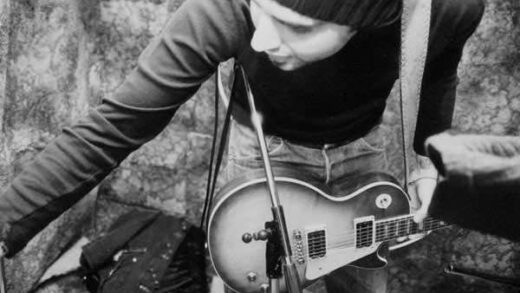
Before you agree that streaming music killed the cult band, consider the strange tales spun in song by Oakland songwriter, vocalist, and musician Richard Shirk.
Shirk’s dreamy, lo-fi, psych-rock new album, Arcadia, has one foot firmly planted in the realm of the three-minute (or less) indie single and the other foot somewhere in a used bookshop in the Midwest browsing vintage Bradbury paperbacks.
AS one listens to the album, it’s evident that Shirk has a good ear for melodies and atmospherics, relying heavily on Casio keyboards, organs and sonic dreamscapes of lo-fi, experimental, psych electro-pop. (Not an easy one to pigeon-hole, nor is it that important)
He likes to describe his sound as “like college radio at one a.m. circa 1982,” and that is quite a fitting metaphor.
He apparently has been influenced by artists like Elliott Smith and Animal Collective. His songs lean towards acoustic, dreamy, experimental electro psych or however you want to string those descriptors together.
Shirk states that one of his favorite songs from Arcadia is “How to Dance How to Waltz.”
“It’s another song that just came to me in the studio and has taken a lot of time to unravel,” he says.
In time for the Halloween/fall season, the track is “a spooky tune in waltz-time about sleepwalking, astral projection, and psychic communication,” says Shirk.
“I’m pretty sure that it takes place in the kind of town that might be in a Borges or Gabriel Garcia-Marques book or short story.”
“I see the last scene taking place in the town hall (built from stone and about a thousand years old) as everyone gathers and in a mass, a communal psychic trip they dance: in a reverie/while keeping in time/they are holding the trance aloft.’”
The song, “The Goal Keeps Moving,” was partly inspired, Shirk noteS, by a Bruce Lee quote: “A goal is not always meant to be reached, it often serves simply as something to aim at.”
Shirk affirmS that he wrote and recorded the song in less than an hour, and during the same session as the single, “Alarms.” One could say he had a burSt of creativity that day.
“I first interpreted the song on the surface as something defeatist and shelved it for a couple of years,” he admits.
The track, he adds, is about “those times in life when everything is in flux and you think that you know what you want, but, in retrospect, you’re being pulled towards something else entirely. The goal is moving,” thus the track’s title.
The cool guitar noodle that Shirk added to the song is performed by musician Ric Wals-Smith who has performed in Japan with Ryuichi Sakamoto’s Yellow Magic Orchestra.
On the album, shirk plays guitar, keys, bass, sax flute and “spooky tubes, bow guitar, morse code, and wine glasses.” His wife performed vocals, keys, and the Glock on various tracks. She wrote the title track and performS the keyboard riff on her Casio SK-1. bassist and pianist LJ Simpson.
The title track, sporting a neat keyboard riff from a Casio SK-1, was written and performed by his wife Susan Chrsanowski.
“‘Arcadia’ is a place, a feeling, an archetype,” Shirk says. “I grew up in Iowa. Though it was near a college town, it was not near enough. I spent a lot of time stranded just a few miles from somewhere I couldn’t get to.”
The song, Shirk says, reminds him of a more simple time as a teen listening to mixtapes in his basement and “learning to play the guitar,” or he adds, “wandering around my small town at three o’clock in the morning when I couldn’t sleep.” He recalls one night of hiking six miles through soybean fields to a neighboring town.
“I navigated by dead reckoning and by walking towards a water tower all lighted up on a moonless night. I really love the refrain in the song: ‘there’s something all around you.’ I’ve always been interested in people who can read auras.”
Songs like “Prisoners at Zenda” and “Secret policemen” lack a bit of imagination and are so lo-fi that they sound like demos. We understand that is part of the intent, but for a 13-track album, every song really needs to count and stand out from the others to get and retain listeners.
The tracks like “At Esalen,” timing in at less than two minutes, with an organ riff driving it on. Apparently the two tracks under the one-minute mark are both about the second largest city in Texas, “Old Suburban Houston” and “Come on Back to Houston.”
The closing track, “Sleep Studies,” is fitting and the extended psychedelic jam is a nice touch to the end of an interesting and unique album that is quite enthralling too – especially for fans of experimental electro-pop lo-fi indie.
Shirk promotes his second album “as a collection of eclectic pop songs about escape – from small towns (‘Arcadia,’ ‘The Goal,’ ‘Secret Policemen,’) to the stars (‘Prisoners of Zenda,’ ‘Come on Back to Houston,’ ‘Old Suburban Houston’), and out from underneath the confines of conventional attitudes towards the supernatural (‘Inner Star Wars,’ ‘Tiger in the Shadows).”
He maintains, and it’s hard to disagree, that the album “rings and chimes with [Shirk’s] trademark spooky guitar tone, spectral voice, and the fingerprints of a childhood spent with pulp science-fiction and a dusty pile of records and warbling tapes by the Cars, the Ramones, and the Fall.”
With plenty of far-out themes and sounds, undeniably catchy hooks, and a persistent spooky vibe is “like a college radio chart countdown in the Twilight Zone.”





